Easy identification, protection from the elements, and better code compliance are just a few benefits of an inexpensive extinguisher accessory
Often, it’s necessary (or simply safer) to place a fire extinguisher outside. Customers, employees, residents, and first responders rely on quick extinguisher access to save lives. That’s true at gas stations, airports, manufacturing facilities, and a wide range of commercial establishments. And in situations where outdoor placement can’t be avoided, an outdoor fire extinguisher cabinet can cut costs, promote safe use, and help fire safety systems pass inspections.
Read on to learn more about the benefits of outdoor extinguisher cabinets and what fire codes and standards have to say about them.
If you’re looking to buy, feel free to skip straight to our selection of fire extinguisher cabinets.
Without an outdoor fire extinguisher cabinet, climate and corrosion can ravage a life-saving device
As we explained in another article on the uses and benefits of plastic fire extinguisher cabinets, each cabinet has two jobs: to protect the extinguisher and make it easy to find.
Mother nature is no friend to fire extinguishers. Prolonged sun exposure tends to fade the inspection and instruction label. That’s a surprisingly serious problem: most inspectors would be within their rights to ask that that extinguisher be removed from service. Local fire codes and standards from the National Fire Protection Association (NFPA) require that labels always remain visible. And annual visual inspections consider the condition of the extinguisher’s operating instructions and the hazardous materials identification system (HMIS) label.
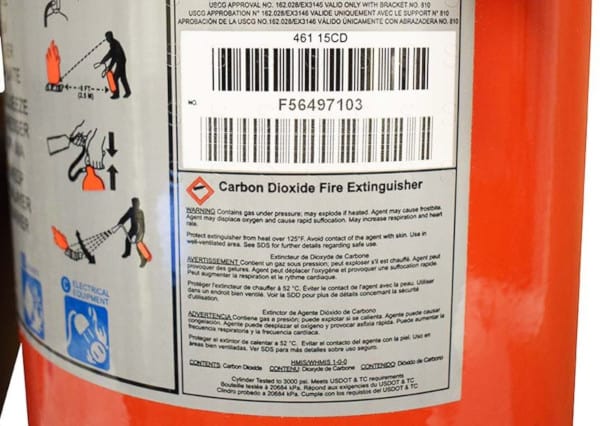
The reason is simple: each extinguisher includes instructions and safety guidelines on the body. Those instructions help consumers safely store, dispose of, and—most importantly—use the extinguisher.
However, fading pales in comparison to the damage moisture can cause outdoor fire extinguishers. When moisture builds up, oxidation (rusting) occurs, and the eventual results could be downright deadly. Stored pressure can transform an extinguisher’s handle into a projectile, or rip the metal cylinder into shrapnel. Rust can lead to leaks that leave an extinguisher inoperable in a fire emergency. Moisture can cause powdered chemicals within to glom together, blocking hoses and other sensitive parts that normally deliver fire-quenching agents. By that point, the extinguisher is just a large, red paperweight.
Outdoor fire extinguisher cabinets can limit accidents, theft, and intentional misuse
Just as nature can damage your fire extinguisher, so can humans. Accidents, like knocking the extinguisher off its mount to the ground, may occur. And while it’s hard to imagine why somebody would want to steal extinguishers, it does happen, whether they’re simply in reach of a burglar or used by vandals to deface buildings.
The fundamental problem is that extinguishers are designed to be accessible to anybody passing nearby. For the most part, access and fire safety trump anti-theft measures. Encasing your fire extinguisher within a locked cabinet, however, can mitigate vandalism, tampering, and misuse that can lead to some expensive messes.
Outdoor fire extinguisher cabinets essentially offer a compromise, shielding these devices behind glass or plastic barriers held in place by a safety lock. Those responsible for the care of extinguishers can unlock the panel and access the extinguisher; emergency users or would-be thieves and vandals must break the barrier. It’s not a perfect deterrent to misuse or accidents—but it is a deterrent because of the noise and extra effort.
NFPA rules and local codes govern locking mechanisms, labeling, and other cabinet-related concerns
Cabinets may be needed as a matter of code compliance
Most cities, states, and other local governments base rules for fire extinguishers on NFPA 10: Standard for Portable Fire Extinguishers. That standard doesn’t demand that all extinguishers, indoor or outdoor, be protected by cabinets. They are, however, an option for remaining in compliance with rules that require proper storage and protection.
For portable extinguishers without wheels, a wall bracket, hanger, wall recess, or cabinet is required (Section 6.1.3.4 of NFPA 10, 2022 edition). However, where these devices are “subject to physical damage,” section 6.1.3.8 requires protection against that damage—which a bracket or hanger may not be able to provide. Cabinets must also be “approved,” meaning that they’re acceptable to local fire officials and other authorities having jurisdiction (AHJs). And they can’t be locked unless the extinguisher is somewhere where it is “subject to malicious use” (being in an outdoor public space typically qualifies) and the cabinet provides means for emergency access. The method of access is a breakable front panel “provided with breaker bars or hammers, designed for accessing the extinguisher during a fire emergency” (Sections 6.1.3.11.1.1 to 6.1.3.11.1.2).
There are no federal regulations requiring outdoor fire extinguishers to remain within a cabinet. Still, some local jurisdictions do require it. It’s crucial to understand local fire codes (and the preferences of local AHJs) to stay fully code-compliant. But in our experience, nearly any extinguisher placed outdoors faces a strong possibility of malicious use. In these cases, an outdoor fire extinguisher cabinet with a lock and key can—and probably should—be used.
Supplement cabinets with signs and decals to promote visibility
Buyers should keep another code-related question in mind: does the cabinet do enough to help users quickly find (and use) the extinguisher?
Rules throughout section 6.1.3.3 of NFPA 10 specify that extinguishers must be placed in a visible location, with additional signs or other visual indicators provided when visual obstructions can’t be avoided. Most outdoor fire extinguisher cabinets help to address the visibility issue with high-contrast colors and added easy-to-read “Fire Extinguisher” decals.
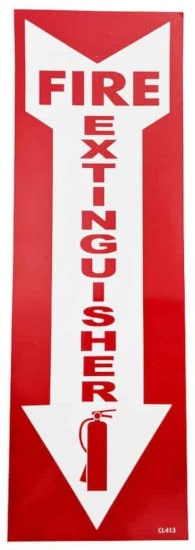
Fully enclosed cabinets are not permitted when very high temperatures are likely
There’s one last factor to keep in mind: airflow may be a concern with extinguishers subjected to especially high temperatures. CO2 models, for instance, shouldn’t be kept at temperatures over 120 degrees Fahrenheit. Where heat is a concern, cabinets must provide “screened openings and drains” in accordance with NFPA 10, section 6.1.3.11.4.
Careful selection can make outdoor fire extinguisher cabinets a cost-saving measure rather than an added expense
Some of the above problems can lead to two undesirable outcomes: recharging or, in some cases, replacing the extinguisher. Depending on the number, sizes, and types required for a facility, those costs can range from inconvenient to prohibitively expensive.
One of the least expensive options for protecting extinguishers outdoors is storing them in a plastic cabinet. These types of cabinets don’t rust or have sharp corners, and the paint doesn’t chip. They also have a built-in lock, and typically feature bright colors along with decals designed to promote compliance with visibility and identification standards.
Surface-mounted cabinets offered by CATO, a Florida-based manufacturer of fire safety products, have all these features. Their frames are injection molded from virgin high-impact crystal polystyrene. The “high-impact” part is exactly what it sounds like: it’s designed not to crack or break when, inevitably, someone or something collides with it. This material also inhibits ultraviolet (UV) rays, slowing down sun-bleaching of the label and degradation of the extinguisher’s parts.
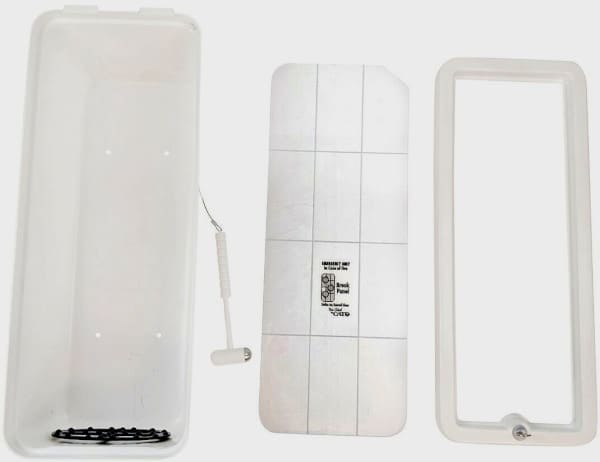
CATO’s cabinets also have a Plaskolite front panel. This acrylic material breaks quickly (and safely) in an emergency, without shattering into a collection of hazardous shards. The cabinets also include a ribbed-grip polypropylene hammer—secured with steel mechanical cable—to make sure that users can get through the panel quickly and safely.
Keep costs lower with affordable cabinets, replacement parts, and long-lasting extinguishers
Extinguisher sizes vary, with some models standing taller and weighing significantly more than others. If you’re looking to find a matching cabinet—or to replace an extinguisher that wasn’t well-protected—take a look at QRFS’s catalog of fire safety equipment. Our CATO-brand cabinets are available for 5-pound, 10-pound, and 20-pound dry chemical and CO2 extinguishers. Damage to locks, keys, hammers, and the break-glass panel can be quickly fixed with our supply of inexpensive replacement parts.
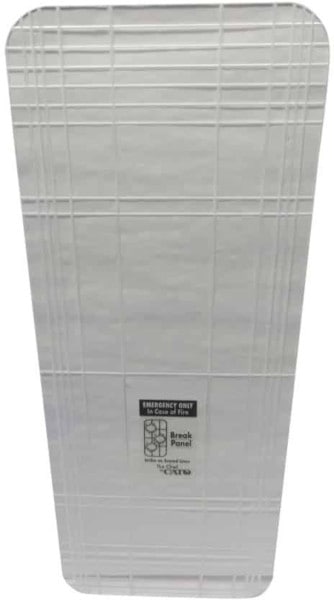
Browse our full selection of extinguishers and accessories, or look at our selection of outdoor fire extinguisher cabinets.
This blog was originally posted at blog.qrfs.com. If this article helped you understand the basics of extinguisher protection, check us out at Facebook.com/QuickResponseFireSupply or on Twitter @QuickResponseFS.


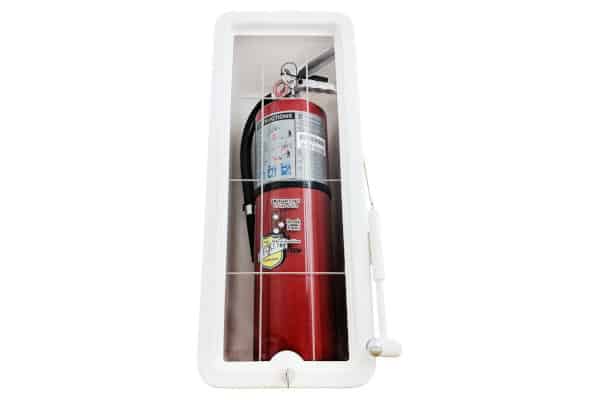
Hi!
I am working on a future project for the condominium I live in.
It is very close to the coast and the metal cabinets have to be replaced frequently.
I like to bring to the board of directors an alternative.
I need to know the size, how strong the box is and of course an approximate price of the unit.
Ana —
QRFS carries plastic fire extinguisher cabinets for extinguishers ranging from 5-20 lbs. in prices ranging from $44.49-$88.75 based on size. How strong are they? Pretty strong; it’s a durable, weather-resistant polystyrene frame that resists corrosion well. They also come with a pre-installed lock, a breakable panel, and an attached, red molded hammer.
Please check out our selection—and email support@qrfs.com or call 888-361-6662 with any questions!